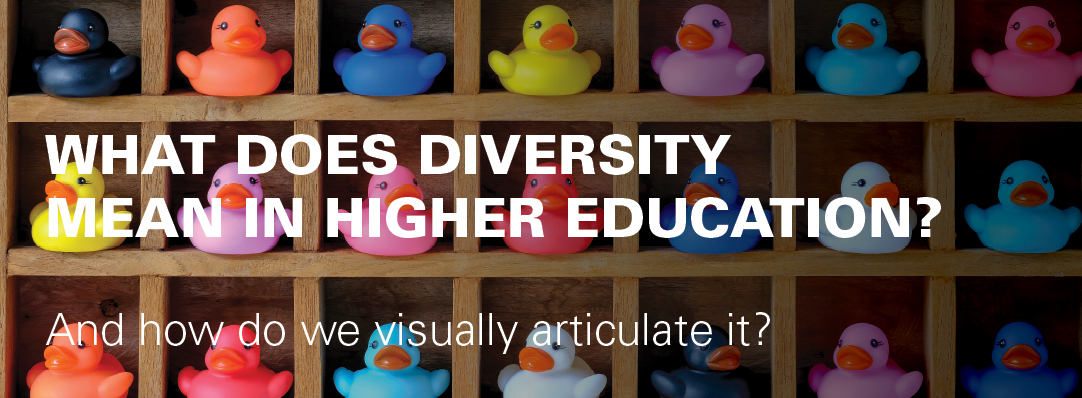
What does diversity mean in higher education?
And how do we visually articulate it?
By Ella Rue
Photograph by Enviromantic
Diversity has long been a ‘go-to’ term on university campuses across the country. To some schools, diversity seems to come naturally simply due to a campus’s respective demographic. But ask different people what diversity means, and answers will usually vary.
Diversity can include race, ethnicity, gender, religion, sexual orientation, geographical representation, political beliefs and more. However, studies also show race, gender and sexual orientation are nearly always the top three concerns for those working in the field. But inclusion is equally important. Race and ethnicity are important, but it’s imperative to not stop there. Sexual orientation, choice of pronouns, where a person came from, all of these are part of what makes up a persons’ identity.
In the wake of the rise of so many student and community protests in addition to the growing activism regarding students of color and minorities feeling unwelcome, universities have intensified their efforts to address topics of diversity. Dr. Barbara Feldman, founding partner of Feldman, Easo and Associates, a consultant firm comprised of college and university administrators specializing in diversity and inclusion says: “The future will be ever more diverse and preparing students to incorporate diverse perspectives into their lives and careers will enhance both their contributions to the world as well as enrich their own experiences.” (Additional information can be found at feldmaneaso.com)
Diversity is typically considered as “the condition of having or being composed of differing elements: variety especially. The inclusion of different types of people (such as people of different races or cultures) in a group or organization programs intended to promote diversity in schools.”
Marketing and communications offices use what resources they have to promote more of what they want. Designers are continuously being asked to visually represent their institution in a realistic manner. The ‘client’ wants their publication request or their website design to accurately reflect their student body. Stock photos are usually reserved for last resort when it comes to representing the student body. So before the design process even starts the university must first make diversity and inclusion a top priority. Once this is established the marketing team can then visually articulate designs that honestly reflect their campus community.
Prioritizing diversity and inclusion
Prioritizing diversity and inclusion in higher education provides advancement opportunity for underrepresented communities.
Hire Strong Advisors
Many minority students will need help planning for academic success. Lacking a family member who can show them how to successfully navigate the college application, major selection and class scheduling labyrinth, these students need clear guidance on course selection, study habits, and managing their finances. Recruiting and hiring well-versed counselors is a must, and these advisors should represent a diverse cross-section of the campus community. It’s imperative that prospective students see themselves when looking at the campus and reviewing the institution’s collateral.
Recruit Diverse Employees
To have a diverse faculty and staff on campus, institutions need to use gender-neutral job descriptions, promote on social media, and offer interviews by video conference for those who live far from campus. Organizations should recognize the need for hires of varying backgrounds, as doing so will better equip the university to serve all students.
Provide Education and Training
Offer training at freshman orientation regarding cross-cultural sensitivity, unconscious bias, and LGBTQ respect.
Assess Regularly
Send surveys and create forums for employees and students to express concerns. This will allow employees and students the opportunity to voice constructive criticism and offer tips for future improvement. Surveys can result in tangible changes, including increased research opportunities for undergraduates, improved career and academic advising, and changes to new student orientation.
Diversity promotes personal growth and a healthy society. Diversity challenges stereotyped preconceptions; it encourages critical thinking; and it helps students learn to communicate effectively with people with different backgrounds than their own
How to Promote Diversity and Inclusion at a University
A top-down, systemic, business-led approach to diversity and inclusion must be adopted and strictly adhered to. It’s imperative that this comes from the top. The president and his or her cabinet must first set this as a key priority. They must communicate that prioritizing diversity will ultimately increase a diverse representation in all areas of an institution from upper administration leadership to faculty, to senior staff to support staff. The entire campus community should represent diversity and inclusion before they can successfully claim to adhere to holding diversity and inclusion as a top priority. Strengthen inclusion. Enable equality of opportunity through fairness and transparency. Lastly, share with transparency, to both campus community and the external community.
Put Your Money Where Your Mouth Is
Make financial support and resources a priority and available to target diverse populations of students and future employees. Provide child care options or expand existing offerings to support students, faculty, and staff with families. Create marketing materials that better and authentically represent diversity at your campus.
Once this is done a conversation can be had about successfully designing for a diverse population.
Designing for Diversity and Inclusion
Much in the same way that the campus should consist of a diverse population marketing collateral should in turn similarly reflect the diversity of the campus community. A commitment should be made to showcase people of all races and genders, differently abled people, and LGBTQ people. Historically marketers want the iconic ‘beauty shot’ to represent their institution. But imagine the powerfully inclusive message that would be sent to a differently abled potential student to see on the cover of a viewbook a student navigating a campus in a wheelchair, or the message of a group of wildly diverse students huddled in the library, amongst their books, studying together. Ultimately, all marketing materials should honestly mirror the institution which reinforces that the campus must first embrace diversity before it can reflect it.